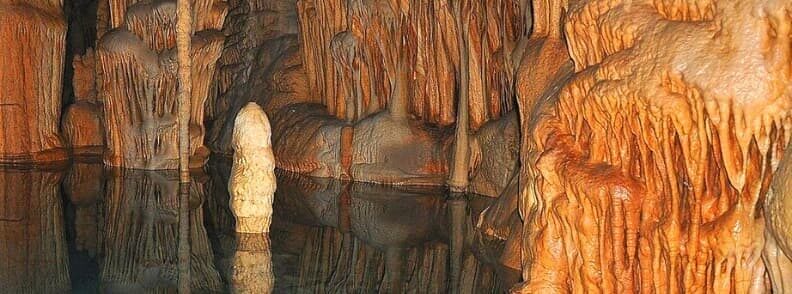Imagine stepping into a world where time seems to stand still, deep beneath the earth’s surface in Austria. Nestled in the picturesque Styria region lies the Katerloch Cave, one of the most captivating limestone formations you’ll ever encounter. This natural wonder isn’t just a geological masterpiece; it’s a hidden gem that offers visitors a magical experience.
Your visit to Katerloch isn’t merely a cave tour—it’s a journey through ancient chambers adorned with awe-inspiring stalactites and stalagmites. Each corner of this subterranean wonder tells a tale of nature’s craftsmanship, slowly carved over millennia. The cave, privately managed, was made accessible to the public thanks to the dedication of Hermann Hofer, whose passion for this hidden treasure led to its preservation and promotion. Hofer’s commitment, alongside his wife Regine, has allowed travelers to witness this underground marvel firsthand.
While touring the depths of Katerloch, visitors are guided through a labyrinth of unique formations, leading to stunning chambers such as the Lake Paradise and the Enchanted Kingdom. The cave even holds connections to Sarma Cave, adding another layer of intrigue to the journey. The entire experience is an adventure that will ignite the imagination of those who seek to uncover the secrets of the earth, away from the usual tourist paths.
So, whether you’re drawn to Katerloch’s mesmerizing limestone formations, intrigued by the story of Hermann Hofer and his exploration, or enticed by the prospect of a serene yet adventurous day trip in Styria, a visit to Katerloch promises an unforgettable experience. Make sure to include Katerloch Cave in your Austrian travel itinerary for a truly magical subterranean adventure!
A Historical Insight: Hermann and Regine Hofer’s Legacy
In the heart of Austria’s Styria region, the story of Hermann Hofer and his wife Regine is intertwined with the discovery and preservation of Katerloch Cave. This couple’s tireless efforts transformed the hidden limestone cave into one of Austria’s most enchanting natural wonders. For years, they explored its depths, mapping out the intricate pathways, discovering mesmerizing chambers, and ensuring its conservation.
Their journey wasn’t without challenges. Navigating through narrow passages and vast chambers, Hermann and Regine faced the immense task of both exploring and protecting Katerloch. Their commitment to making the cave accessible to the public required immense perseverance and passion.
Over time, the Hofer family’s dedication allowed visitors from around the world to experience this geological marvel firsthand. Their work has not only preserved the cave for future generations but also ensured that it remains a place of awe and inspiration. Today, a visit to Katerloch is a tribute to the legacy of Hermann Hofer, who uncovered one of Austria’s most pristine underground treasures, showcasing the beauty of nature’s hidden wonders.
What to Expect During Your Visit to Katerloch
A visit to Katerloch Cave is nothing short of an extraordinary adventure. The journey begins at the Marteldome, a towering 45-meter-deep vertical shaft used by Hermann Hofer and his wife Regine during their initial explorations. Right from the start, the cave’s sense of history and grandeur captivates visitors. Fritz Geissler, an experienced guide, leads the way through narrow paths and ladders, helping you navigate this magnificent limestone world.
The first major cavern you’ll encounter is the Fantasy Hall, a vast chamber stretching 120 meters long, 85 meters wide, and 15 meters high. As Geissler describes the geological formations, he points to the intricate limestone corals, delicate white and colored curtains, and the remarkable stalagmites and stalactites that seem to grow towards each other until they form fully bonded columns. This hall alone showcases nature’s remarkable patience and artistry, giving visitors a glimpse of formations that have taken millions of years to develop.
One of the highlights of the tour is Seenparadies or Lake Paradise, a serene underground lake whose still waters reflect the stalactites hanging above. It’s easy to understand why this chamber is called paradise. Another stop on the tour is the Zauberreich or Enchanted Kingdom, where the interplay of light and the otherworldly shapes of the stalactites and stalagmites create a truly mesmerizing scene.
In addition to these iconic features, Katerloch Cave also shares an underground connection with Sarma Cave, making the Katerloch tour a part of a larger subterranean network. While exploring the cave, the guide may highlight this relationship, adding to the cave’s allure and mystery.
The tour lasts around two hours, but the memories last much longer. With its narrow passageways, awe-inspiring formations, and fascinating history, a visit to Katerloch Cave is a must for any adventurer looking to uncover the hidden beauty beneath Austria’s surface.
Highlights of the Katerloch Cave Tour
As you embark on your visit to Katerloch, the tour unveils a series of awe-inspiring natural wonders that make this cave truly exceptional. One of the most striking features is the abundance of stalactites and stalagmites, some of which rank among the largest in Europe. These formations, sculpted over thousands of years, create a surreal landscape, with delicate crystal draperies hanging from above and massive columns rising from the cave floor.
Each chamber offers something unique. The “Hall of Magic” is a particularly mesmerizing space, where the light plays off intricate limestone formations, giving the impression of a hidden fairy-tale world. Another highlight is the “Lake Paradise,” a serene underground lake that reflects the beauty of the formations above, creating a picture-perfect moment that leaves visitors in awe.
During the tour, you’ll also dive into the fascinating Katerloch cave history, learning about how Hermann Hofer and his wife, Regine, discovered and preserved these caverns. Their dedication to showcasing the cave’s natural beauty has allowed adventurers to explore this pristine environment, while also understanding its historical and geological significance.
The blend of dramatic natural features and rich history make the Katerloch Cave tour a once-in-a-lifetime experience, perfect for both nature enthusiasts and history buffs.
Visiting Practicalities: Tickets, Timings, and Access
Planning your visit to Katerloch Cave requires attention to some practical details to ensure a smooth and enjoyable experience. Guided tours are available but must be booked in advance, as group sizes are limited to maintain the intimate and educational nature of the visit. Typically, groups range from 8 to 15 people, allowing each visitor to fully engage with the guide and the surroundings.
Ticket prices vary depending on age, with discounts available for children and students, making it a family-friendly destination. Tours last around two hours, taking visitors through the cave’s highlights, including the stunning Lake Paradise and the intricate stalactite formations. It’s advisable to wear comfortable walking shoes and bring a light jacket, as the cave maintains a cool temperature year-round.
Tropfsteinhöhle Katerloch is accessible by car and located near the town of Weiz, with plenty of parking available. Visitors are encouraged to plan their trips between May and October, as the cave is typically closed during the winter months to preserve its delicate ecosystem. For those seeking a more immersive day in nature, the surrounding region offers beautiful hikes, such as the Raabklamm Gorge, to complement your visit to Katerloch Cave.
Nearby Attractions: Raabklamm Gorge
Just a short drive from Katerloch Cave, the Raabklamm Gorge offers an incredible opportunity to connect with nature on a deeper level. Known as one of the longest and most scenic gorges in Austria, Raabklamm is a must-visit for outdoor enthusiasts. The Raabklamm hike is the perfect complementary experience to your cave exploration, providing a refreshing contrast between the underground and open-air wilderness. The hike, suitable for all levels, winds along the Raab River, revealing stunning waterfalls, lush forests, and diverse wildlife.
As you traverse the Raabklamm Gorge, you’ll be enveloped by the raw beauty of Styria’s countryside. Whether you’re in for a challenging adventure or a leisurely walk, the Raabklamm hike offers flexibility with both upper and lower trail options. Along the way, you’ll pass historic mills and picturesque bridges, adding cultural flavor to your journey.
For those visiting Katerloch Cave, a Raabklamm hike is an excellent way to experience the natural beauty of Austria. From the fascinating subterranean world of Katerloch to the open expanse of Raabklamm, this duo of attractions creates the ultimate nature-lovers itinerary.
Why You Should Visit Katerloch Cave in Styria
If you’re seeking an off-the-beaten-path adventure in Austria, Katerloch Cave in Styria should be at the top of your list. Its breathtaking limestone formations, serene underground lakes, and the dedication of Hermann Hofer in uncovering its wonders make it a unique travel destination. A visit to Katerloch offers a chance to explore nature’s artistry up close, while nearby attractions like the Raabklamm Gorge add to the experience, making it an ideal day trip for nature lovers and adventurers alike.
Whether you’re captivated by the stories of the Hofer family, the allure of hidden chambers deep below the earth, or the tranquility of the Sarma Cave connection, Katerloch offers something for every type of traveler. This cave system is more than just a geological wonder; it’s a symbol of perseverance and beauty that transcends time. If you’re planning a trip to Austria, make sure to include a visit to Katerloch in your itinerary.
Book your guided tour and experience the magic of this lesser-known gem in Styria, where each chamber tells a story of history, nature, and adventure.
Visit to Katerloch featured image: Ingeborg56 [CC BY-SA 3.0]

Born in Austria and now based in Canada, Sarah Grossman combines her roots and passion for travel to offer unparalleled insights into destinations like Katerloch Cave and the broader Austrian landscape. As a seasoned traveler and meticulous planner, Sarah’s deep knowledge of her homeland, paired with her global travel expertise, makes her the perfect guide for those seeking authentic, insider tips. Her first-hand experiences and love for adventure ensure that she provides advice that is both practical and inspiring for anyone planning a visit to Austria.
With years of personal exploration and a talent for sharing captivating travel stories, Sarah is an authority when it comes to uncovering hidden gems like Katerloch Cave. Her travel advice is not only grounded in experience but also designed to motivate others to embark on their adventures. Sarah’s dedication to helping travelers discover the best of Austria ensures that her readers always find the most reliable and engaging travel tips, from cave exploration to the scenic wonders of Styria.
You too can become a guest blogger on The Travel Bunny. Just submit a free guest post.
Other travel blog articles you should read on The Travel Bunny
Why I love to go back and travel to Austria
The amazing Austria wine region of Southwestern Styria
Skiing in Austria: Best ski resorts in the Austrian Alps

